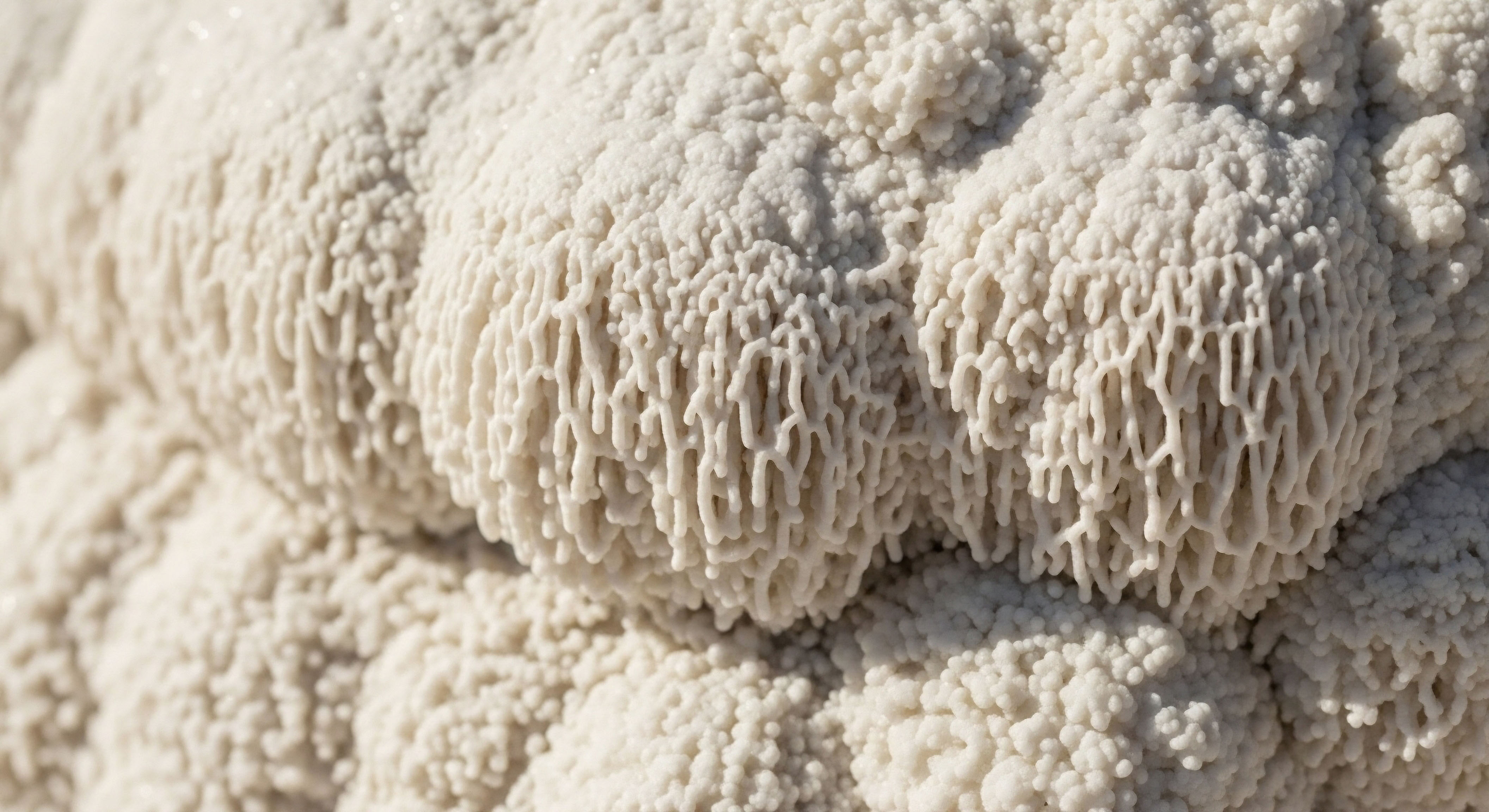

Fundamentals
You feel it as a subtle shift in your body’s internal landscape. The energy that once came easily now feels distant. Recovery from physical exertion takes longer, and maintaining the lean, strong physique of your younger years requires a level of effort that seems unsustainable.
This experience, this lived reality of change, is a valid and important signal from your body. It is a call to understand the intricate communication network that governs your vitality. At the center of this network is a molecule of profound importance for adult wellness ∞ human growth hormone (HGH). Your body’s capacity to produce it is the foundation upon which your metabolic health is built, and it is possible to meaningfully influence its levels through dedicated, intelligent lifestyle choices.
The conversation about HGH in adulthood is about repair, regeneration, and metabolic regulation. Its name, a holdover from its role in childhood development, obscures its lifelong function. In the adult body, HGH acts as a master signaling molecule released by the pituitary gland.
It travels through the bloodstream to interact with nearly every tissue, orchestrating a complex set of processes that define how you look and feel. It instructs your body to mobilize stored fat for energy, encourages the preservation and synthesis of lean muscle tissue, and supports the constant work of cellular repair that keeps your systems functioning optimally. When HGH levels are robust, the body operates with a certain metabolic grace. When they decline, the system can feel sluggish and inefficient.

The Rhythmic Pulse of Hormonal Communication
Your body does not release HGH in a steady stream. Its secretion is pulsatile, occurring in bursts that are governed by a sophisticated feedback loop within the brain. This system, known as the hypothalamic-pituitary axis, functions through the interplay of two primary signaling hormones from the hypothalamus.
Growth hormone-releasing hormone (GHRH) acts as the accelerator, signaling the pituitary to release a pulse of HGH. Somatostatin acts as the brake, inhibiting its release. This elegant system ensures that HGH is secreted at the right times and in the right amounts, creating a natural rhythm that changes throughout a 24-hour cycle. The largest and most significant of these pulses is deeply connected to a fundamental human behavior.
The body’s primary release of human growth hormone is intricately linked to the deepest stages of sleep, highlighting its critical role in daily restoration.
Understanding this natural rhythm is the first step toward optimizing it. The three most powerful, non-pharmacological levers we can pull to influence this system are rooted in the core tenets of human physiology. These pillars represent the foundational work required to support your body’s innate capacity for hormonal balance and vitality. Each one sends a powerful signal to the hypothalamic-pituitary axis, encouraging the release of this vital hormone.

The Pillar of Deep Sleep
The most significant and restorative pulse of HGH occurs during the first few hours of sleep, specifically in concert with slow-wave sleep (SWS), the deepest and most physically restorative phase. During this window, the brain’s production of GHRH surges while somatostatin is suppressed, creating the ideal conditions for a robust release of HGH.
This sleep-driven pulse is so crucial that it can account for a majority of the total HGH secreted in a 24-hour period. Inadequate or fragmented sleep directly disrupts this process, blunting the nocturnal surge and depriving the body of its most important period of repair and regeneration. Prioritizing consistent, high-quality sleep is therefore the single most effective lifestyle strategy for supporting healthy HGH levels.

The Pillar of Intense Physical Exertion
Vigorous exercise provides another powerful stimulus for HGH secretion. This phenomenon, known as the exercise-induced growth hormone response (EIGR), is directly related to the intensity of the activity. Workouts that push the body beyond its comfort zone, particularly those that generate significant levels of lactic acid, send a strong signal to the pituitary gland.
High-intensity resistance training with short rest periods and high-intensity interval training (HIIT) are particularly effective. The lactate produced during such exertion appears to be a key signaling molecule that directly stimulates the hypothalamus and pituitary, triggering a substantial release of HGH to aid in tissue repair and adaptation following the workout.

The Pillar of Metabolic State
The third pillar involves the intricate relationship between HGH and insulin, the hormone that manages blood sugar. These two hormones function in a reciprocal balance. High levels of circulating insulin, typically seen after a meal rich in carbohydrates and sugar, suppress HGH secretion. Conversely, periods of low insulin create a permissive environment for HGH release.
This is the mechanism behind the significant HGH spikes observed during fasting. When the body is in a fasted state, insulin levels fall, signaling the body to mobilize stored energy. This state simultaneously opens the door for increased HGH secretion, which aids in this process by preserving muscle mass while promoting the use of fat for fuel. Reducing sugar intake and incorporating periods of intermittent fasting are direct ways to leverage this powerful metabolic relationship.
- Sleep Quality ∞ The largest pulse of HGH is released during the initial phase of slow-wave sleep, making deep, uninterrupted rest a primary factor.
- Exercise Intensity ∞ High-intensity exercise that produces lactate serves as a potent, acute stimulus for HGH release from the pituitary gland.
- Insulin Levels ∞ HGH and insulin have an inverse relationship; therefore, managing blood sugar and practicing intermittent fasting can create favorable conditions for HGH secretion.


Intermediate
Having established that sleep, exercise, and nutrient timing are the foundational pillars for natural HGH optimization, a deeper inquiry into the underlying mechanisms reveals a more intricate and targetable system. The simple model of a GHRH “accelerator” and a somatostatin “brake” expands to include a third, equally important player ∞ ghrelin.
Primarily produced in the stomach, ghrelin is often known as the “hunger hormone,” yet its role extends far beyond appetite. It is also one of the most potent stimulators of HGH secretion, acting on its own distinct receptor in the pituitary and hypothalamus, the growth hormone secretagogue receptor (GHS-R). Understanding the interplay of these three signaling pathways ∞ GHRH, somatostatin, and ghrelin ∞ allows for a more refined approach to lifestyle interventions and provides the scientific rationale for advanced clinical protocols.

Architecting Your Biology for Optimal Release
Moving from general principles to specific protocols requires a conscious effort to structure your daily life in a way that aligns with your body’s endocrine rhythms. This means going beyond simply “getting more sleep” and instead focusing on sleep architecture, and transforming a workout from simple movement into a precise hormonal stimulus.

What Are the Best Protocols for Sleep Optimization?
The goal is to maximize the duration and quality of slow-wave sleep (SWS). The HGH pulse is tied directly to this phase, which is most prominent in the first half of the night. Strategies to enhance SWS include:
- Temperature Regulation ∞ A slight drop in core body temperature is a key signal for sleep onset and deep sleep. Keeping the bedroom cool (around 18°C or 65°F) can facilitate this process.
- Light Exposure ∞ Complete darkness is essential. Exposure to light, particularly blue light from screens, before bed can suppress melatonin production and delay the onset of SWS.
- Meal Timing ∞ A large meal, especially one high in carbohydrates, close to bedtime can raise insulin levels, which directly antagonizes the nocturnal HGH pulse. Finishing your last meal at least three hours before sleep is a critical step.
- Alcohol Avoidance ∞ While alcohol may induce drowsiness, it significantly disrupts sleep architecture later in the night, specifically suppressing SWS and fragmenting sleep.

Designing Exercise for a Hormonal Response
The key variable in the exercise-induced growth hormone response is intensity that generates a significant metabolic demand. The accumulation of lactate appears to be a primary trigger for the pituitary’s response. The following table compares different training modalities.
| Exercise Modality | Description | HGH Impact | Primary Mechanism |
|---|---|---|---|
| High-Intensity Resistance Training | Lifting moderate to heavy loads (6-12 rep range) with short rest intervals (60-90 seconds). | High | Significant lactate accumulation and muscle fiber recruitment. |
| High-Intensity Interval Training (HIIT) | Short bursts of maximal effort (e.g. 30-second sprints) followed by brief recovery periods. | High | Exceeding the lactate threshold repeatedly. |
| Steady-State Endurance | Prolonged, moderate-intensity aerobic exercise (e.g. jogging). | Moderate | Dependent on duration and staying above a certain intensity threshold. |
| Low-Intensity Activity | Walking, stretching, or yoga. | Low to None | Does not typically cross the intensity threshold needed for a significant EIGR. |
Even with optimized lifestyle habits, the age-related decline in pituitary sensitivity presents a biological reality that may limit natural HGH production.

The Biological Ceiling and the Role of Peptide Therapy
It is a biological fact that HGH secretion declines with age, a process known as somatopause. This decline begins in the third or fourth decade of life and continues progressively. It is driven by a reduction in GHRH release and an increase in somatostatin tone, leading to smaller and less frequent HGH pulses.
For many, there comes a point where even the most diligent lifestyle practices cannot fully counteract this natural decline. The pituitary gland becomes less responsive to the brain’s signals. This is where the conversation transitions from purely natural optimization to clinical support designed to restore youthful signaling patterns.
Growth hormone peptide therapies are a sophisticated class of compounds that work by interacting with the body’s own regulatory systems. They are not synthetic HGH. Instead, they are secretagogues ∞ molecules that signal the pituitary gland to produce and release its own HGH. This approach preserves the natural, pulsatile release of HGH, which is a safer and more physiologically sound method than introducing a constant, high level of external hormone. Two of the most well-researched peptides are Sermorelin and Ipamorelin.

How Do Key HGH Peptides Work?
Sermorelin and Ipamorelin work on different pathways to achieve a synergistic effect, essentially addressing the age-related decline from two different angles.
- Sermorelin ∞ This peptide is an analog of GHRH. It is a fragment of the natural GHRH molecule (the first 29 amino acids) that retains its full biological activity. Sermorelin works by binding to the GHRH receptor on the pituitary gland, directly stimulating it to produce and secrete HGH. It effectively replaces the diminished signal from the hypothalamus, acting as a powerful “accelerator.”
- Ipamorelin ∞ This peptide is a selective ghrelin mimetic. It binds to the GHS-R, the same receptor that ghrelin uses. This action stimulates HGH release through a separate and complementary pathway to Sermorelin. Ipamorelin is highly valued for its selectivity; it stimulates HGH release without significantly affecting other hormones like cortisol or prolactin. By activating the ghrelin pathway, it provides a second, powerful stimulus for the pituitary to release HGH.
The combined use of Sermorelin and Ipamorelin represents a dual-action approach. Sermorelin restores the primary “go” signal, while Ipamorelin provides a potent, secondary signal, leading to a more robust and natural pulse of HGH release than either could achieve alone. This strategy is designed to rejuvenate the body’s own endocrine machinery, a clinical translation of the goal to restore youthful vitality.


Academic
A sophisticated understanding of human growth hormone (HGH) regulation transcends lifestyle factors and enters the realm of molecular endocrinology, focusing on the specific interactions between signaling peptides and their cognate receptors. The age-related decline in somatotropic axis function, or somatopause, is characterized by a diminished amplitude and frequency of HGH secretory pulses.
This is not merely a failure of the pituitary somatotrophs but a systems-level dysregulation involving decreased hypothalamic Growth Hormone-Releasing Hormone (GHRH) and increased somatostatin (SST) output. While lifestyle interventions can modulate this system, a more direct biochemical recalibration is achievable through peptide therapies that target distinct receptor pathways.
The synergistic action of GHRH analogs, such as Sermorelin, and Growth Hormone Secretagogues (GHS), like Ipamorelin, offers a compelling model for physiological restoration by simultaneously activating two separate intracellular signaling cascades within the pituitary somatotroph.

The Molecular Synergy of GHRH and GHS Receptor Activation
The foundation of this synergistic effect lies in the distinct downstream signaling pathways initiated by the GHRH receptor (GHRH-R) and the GH secretagogue receptor (GHS-R1a). These two G-protein coupled receptors (GPCRs) represent the primary positive regulators of HGH secretion.

How Do Receptor Pathways Influence HGH Secretion?
The binding of a ligand to its receptor initiates a cascade of intracellular events. For HGH regulation, two distinct pathways converge to produce a powerful effect.
- The GHRH Receptor Pathway ∞ When Sermorelin (or endogenous GHRH) binds to the GHRH-R, it primarily couples to the Gs alpha subunit of its associated G-protein. This activation stimulates the enzyme adenylyl cyclase, leading to an increase in intracellular cyclic adenosine monophosphate (cAMP). cAMP then activates Protein Kinase A (PKA), which phosphorylates a variety of downstream targets. This PKA-mediated phosphorylation is critical for two main actions ∞ it promotes the transcription of the GH gene, leading to synthesis of new hormone, and it facilitates the exocytosis of vesicles containing pre-synthesized HGH.
- The GHS-R1a Pathway ∞ When Ipamorelin (or endogenous ghrelin) binds to the GHS-R1a, it primarily couples to the Gq alpha subunit. This activates the enzyme phospholipase C (PLC), which cleaves phosphatidylinositol 4,5-bisphosphate (PIP2) into two second messengers ∞ inositol trisphosphate (IP3) and diacylglycerol (DAG). IP3 binds to receptors on the endoplasmic reticulum, causing a rapid release of stored intracellular calcium (Ca2+). The subsequent rise in cytosolic Ca2+ is a potent trigger for the fusion of HGH-containing secretory vesicles with the cell membrane, resulting in a rapid pulse of hormone release. Simultaneously, DAG activates Protein Kinase C (PKC), which also plays a role in sustaining the secretory response.
The synergy arises from the interaction between these two systems. The GHS-R1a-mediated signaling cascade appears to potentiate the effects of the GHRH-R pathway. The activation of PKC by the ghrelin/Ipamorelin pathway can enhance the somatotroph’s sensitivity to GHRH, leading to a greater cAMP response for a given amount of GHRH stimulation.
This means that activating both receptors at once results in an HGH pulse that is greater in amplitude than the simple sum of the effects of each peptide administered alone. This dual-receptor activation more closely mimics the robust signaling environment of a youthful endocrine system.
The clinical objective of dual-peptide therapy is to restore the natural pulsatility of HGH release, which is crucial for its physiological effects without causing receptor desensitization.

Restoring Physiological Pulsatility
The pulsatile nature of HGH secretion is a critical feature of its physiology. It prevents the downregulation of HGH receptors in peripheral tissues and allows for precise temporal regulation of its metabolic effects. The administration of exogenous, non-pulsatile HGH can override this delicate system, leading to sustained high levels of the hormone and its mediator, Insulin-like Growth Factor 1 (IGF-1).
This can result in adverse effects such as insulin resistance and edema. Peptide therapies, by contrast, work by stimulating the body’s own secretory machinery, thereby preserving and amplifying the natural pulsatile rhythm. The following table outlines the key differences in these therapeutic approaches.
| Attribute | Exogenous HGH Therapy | Dual Peptide Therapy (Sermorelin/Ipamorelin) |
|---|---|---|
| Mechanism of Action | Direct replacement with synthetic HGH. | Stimulates the pituitary to release endogenous HGH. |
| Release Pattern | Creates a non-physiological, sustained elevation (a square wave). | Induces and amplifies natural, pulsatile release. |
| Feedback Loop | Suppresses the hypothalamic-pituitary axis via negative feedback from high IGF-1. | Works within the natural feedback loop; release is still modulated by somatostatin. |
| Pituitary Health | Can lead to atrophy of pituitary somatotrophs over time due to disuse. | Stimulates and supports the function of pituitary somatotrophs. |
The use of a GHRH analog combined with a GHS represents a sophisticated, systems-based approach to addressing somatopause. It acknowledges the multifactorial nature of the age-related decline in HGH and targets multiple points in the regulatory pathway.
This strategy aims to restore not just the level of the hormone, but the physiological rhythm that is essential for its safe and effective action in the body. It is a clinical application of endocrinological first principles, moving beyond simple replacement toward intelligent biochemical recalibration.

References
- Godfrey, Richard J. et al. “The exercise-induced growth hormone response in athletes.” Sports Medicine, vol. 33, no. 8, 2003, pp. 599-613.
- Godfrey, R. J. et al. “The role of lactate in the exercise-induced human growth hormone response ∞ evidence from McArdle disease.” British Journal of Sports Medicine, vol. 43, no. 7, 2009, pp. 521-525.
- Van Cauter, Eve, et al. “Physiology of growth hormone secretion during sleep.” The Journal of Pediatrics, vol. 128, no. 5, Pt 2, 1996, pp. S32-S37.
- Moller, N. and J. O. L. Jorgensen. “Effects of growth hormone on glucose, lipid, and protein metabolism in human subjects.” Endocrine Reviews, vol. 30, no. 2, 2009, pp. 152-177.
- Kojima, Masayasu, et al. “Ghrelin is a growth-hormone-releasing acylated peptide from stomach.” Nature, vol. 402, no. 6762, 1999, pp. 656-660.
- Camanni, F. et al. “Endocrine activities of ghrelin, a natural growth hormone secretagogue (GHS), in humans ∞ comparison and interactions with hexarelin, a nonnatural peptidyl GHS, and GH-releasing hormone.” The Journal of Clinical Endocrinology & Metabolism, vol. 86, no. 11, 2001, pp. 5134-5138.
- Sigalos, J. T. and A. W. Pastuszak. “The Safety and Efficacy of Growth Hormone Secretagogues.” Sexual Medicine Reviews, vol. 6, no. 1, 2018, pp. 45-53.
- Ho, K. Y. et al. “Fasting enhances growth hormone secretion and amplifies the complex rhythms of growth hormone secretion in man.” Journal of Clinical Investigation, vol. 81, no. 4, 1988, pp. 968-975.
- Nass, R. et al. “Effects of an oral ghrelin mimetic on body composition and clinical outcomes in healthy older adults ∞ a randomized, controlled trial.” Annals of Internal Medicine, vol. 149, no. 9, 2008, pp. 601-611.
- Walker, R. F. “Sermorelin ∞ a better approach to management of adult-onset growth hormone insufficiency?” Clinical Interventions in Aging, vol. 1, no. 4, 2006, pp. 307-308.

Reflection

Charting Your Own Path to Vitality
The information presented here offers a map of the complex biological territory governing your body’s vitality. It details the pathways, the signals, and the rhythms that dictate a significant part of how you feel and function each day. This knowledge is a powerful tool.
It transforms the abstract feeling of “slowing down” into a series of understandable, and therefore addressable, physiological events. You now have a framework for understanding how the choices you make each day ∞ how you sleep, how you move, and how you eat ∞ are in direct conversation with your endocrine system.
This journey of understanding is deeply personal. Your unique genetic makeup, your health history, and the demands of your life create a biological context that is yours alone. The effectiveness of these natural strategies will be unique to you.
For some, a dedicated focus on sleep hygiene and exercise intensity will be enough to restore a profound sense of well-being. For others, this diligent work will form the essential foundation upon which more targeted clinical support can be built. The goal is to function without compromise.
Viewing this knowledge as the first step empowers you to engage in a more meaningful dialogue about your health, whether that is with yourself as you refine your lifestyle, or with a qualified clinical professional who can help you interpret your body’s signals and explore a personalized path forward.

Glossary

human growth hormone

pituitary gland

hypothalamic-pituitary axis

growth hormone-releasing hormone

ghrh

slow-wave sleep

exercise-induced growth hormone response

hgh secretion

hgh release

ghrelin

growth hormone secretagogue

exercise-induced growth hormone

somatopause

growth hormone

ipamorelin

age-related decline

sermorelin

ghs-r1a




